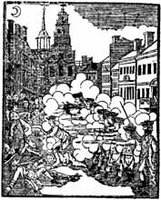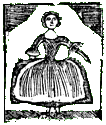Serena Zabin on Military Families in Boston, 3 Dec.
 This is probably the Revolutionary-history event that I’ve been looking forward to most this season. On Tuesday, 3 December, the Boston Area Early American History Seminar, which meets at the Massachusetts Historical Society, will host a discussion of Serena Zabin’s paper on “Occupying Boston: An Intimate History of the Boston Massacre.”
This is probably the Revolutionary-history event that I’ve been looking forward to most this season. On Tuesday, 3 December, the Boston Area Early American History Seminar, which meets at the Massachusetts Historical Society, will host a discussion of Serena Zabin’s paper on “Occupying Boston: An Intimate History of the Boston Massacre.”
Back early in my own research on the Massacre, I stumbled across the name of Pvt. James Hartigan in Boston’s published vital records. He married a woman named Elizabeth Henderson at Trinity Church on 2 Sept 1769. Five months later, Hartigan was one of the soldiers shooting into the mob on King Street. As the Legal Papers of John Adams had already noted, a Boston official went through the ritual of warning Elizabeth Hartigan out of town while her husband was in jail. (For more of their story, see this posting.)
Serena Zabin, who’s a professor at Carleton College, has been working along the same lines, but on a bigger scale. According to the seminar description:
As the records of some forty marriages of military men and more than a hundred baptisms of their children make clear, women constituted a fundamental component of the British army’s experience in Boston. This chapter from a larger study of the intimate occupation of Boston examines the personal, social, and political meanings of these new families.I lucked out because the town records clearly label Hartigan as a private in the 29th Regiment. I don’t recall seeing so many other military men identified in the marriage and baptism data. I therefore guess that Prof. Zabin has been cross-referencing muster rolls and church records. And what other sources might she have found about the lives of these military families? Were soldiers marrying woman already attached to the army, newcomers to Boston, or local girls? What was it like to be one of the children traveling with the king’s army to this hostile town? The sources may not survive to answer those questions, but they comprise one of the few unexplored aspects of the Massacre.
This seminar will start at 5:15 P.M. at the M.H.S. at 1154 Boylston Street. Prof. Zabin’s paper will be available for reading beforehand. She’ll start the discussion with a few remarks, Prof. Lisa Wilson of Connecticut College will respond to the points raised in the paper, and then other participants may join in. Members of the public are welcome to attend; the society asks people to send a message if they’re coming so staffers know how many chairs and sandwiches to put out.

